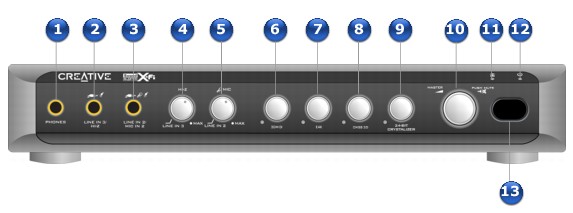Your Sound Blaster X-Fi I/O Console*
The X-Fi I/O Console provides additional connectivity for a number of other devices.
Front panel

| |
Jack or Dial
|
Description
|
|
1.
|
Headphone jack
|
Connect stereo headphones with a 6.35 mm (1/4-inch) stereo plug to this jack. Speaker output will be muted if the Automatically mute speakers check box is selected in Audio Console or Entertainment Mode. For more information, refer to their online Help.
|
|
2.
|
Line In 3/Hi-Z jack
|
Connect a line-level source (such as a cassette, DAT or MiniDisc player) to this jack. You can also connect a low output impedance device such as an electric guitar when Hi-Z is enabled.
Hi-Z offers high input impedance to match the load delivered by low output impedance devices. This eliminates the need to run such devices through pre-amp equipment.
|
|
3.
|
Line In 2/Mic In 2 jack
|
Connect a line-level source (such as a cassette, DAT or MiniDisc player, or an electric guitar running through a Pre-amp FX Box) or a microphone to this jack.
|
|
4.
|
Line In 3/Hi-Z dial
|
Selects Line In 3 or Hi-Z. Also controls the input gain. Turn the dial clockwise to increase the input gain, and counterclockwise to decrease the input gain.
To select Line In 3 for line-level sources, turn the dial counterclockwise over the separator mark  until you hear a "click". To select Hi-Z for low output impedance devices such as an electric guitar, turn the dial clockwise over the separator mark until you hear a "click".
|
|
5.
|
Line In 2/Mic In 2 dial
|
Selects Line In 2 or Mic In 2. Also controls the input gain. Turn the dial clockwise to increase the input gain, and counterclockwise to decrease the input gain.
To select Line In 2 for line-level sources, turn the dial counterclockwise over the separator mark  until you hear a "click". To select Mic In 2, turn the dial clockwise over the separator mark until you hear a "click".
|
|
6.
|
3DMIDI dial
|
Turns 3DMIDI on or off when pressed. Turn the dial clockwise or counterclockwise to adjust the pan spread of the MIDI source in relation to the Front direction on the horizontal plane.
|
|
7.
|
EAX dial
|
Turns EAX on or off when pressed. Turn the dial clockwise or counterclockwise to adjust the amount of EAX effect applied.
|
|
8.
|
X-Fi CMSS-3D dial
|
Turns X-Fi CMSS-3D on or off when pressed. Turn the dial clockwise or counterclockwise to adjust the amount of stereo envelopment between the front and surround channels on a multispeaker system, or the amount of virtualization on a pair of stereo speakers.
|
|
9.
|
X-Fi Crystalizer dial
|
Turns the X-Fi Crystalizer effect on or off when pressed. Turn the dial clockwise or counterclockwise to adjust the amount of X-Fi Crystalizer effect applied.
|
|
10.
|
Master Volume/Mute dial
|
Controls the combined level of all audio handled through the X-Fi I/O Console. Cuts off all audio when pressed.
|
|
11.
|
Infrared Light Emitting Diode (LED)
|
Lights up when infrared signals are received from the remote control*.
|
|
12.
|
Power LED
|
Lights up and remains constant when power is supplied to the X-Fi I/O Console. Blinks when the Mute function is enabled.
|
|
13.
|
Infrared receiver
|
Receives infrared signals from the remote control* and transmits them to your computer.
|
Rear panel
| |
Jack or Connector
|
Description
|
|
1.
|
Auxiliary 2 Line In/Phono In switch
|
Switches between line level or phono sources.
|
|
2.
|
Auxiliary 2 Line In/Phono In jacks
|
Supports line level or phono sources, depending on which setting is currently selected using the Auxiliary 2 Line In/Phono In switch.
When Auxiliary 2 Line In is selected:
- Connect one end of an RCA cable to these jacks. Connect the other end to the RCA outputs on line level devices like VCRs, TVs and CD players.
|
When Phono In is selected:
- Connect one end of a phono cable to these jacks. Connect the other end to a vinyl record player.
|
3.
|
DIN jack
|
Connect Creative analog speaker systems that have a Volume Control jack (9-pin DIN jack). For more information, see About the DIN Jack.
|
|
4.
|
MIDI In/Out connectors
|
Connect MIDI devices to these connectors using standard MIDI cables.
|
|
5.
|
Optical SPDIF In/Out jacks
|
Connect recording/playback devices with optical jacks (for example, MiniDisc recorders, Digital Audio Tape recorders or external hard disk recorders) to these jacks.
|
|
6.
|
Coaxial SPDIF In/Out jacks
|
Connect digital audio recording/playback devices with coaxial jacks (for example, MiniDisc recorders, Digital Audio Tape recorders or external hard disk recorders) to these jacks.
|
|
7.
|
AD_Link (26 pin) connector
|
Connect one end of the AD_Link cable to this connector. Connect the other end to the AD_Link connector on your Sound Blaster X-Fi audio card.
|
Notes
- *Available with some models of your audio device, or as an upgrade accessory in some regions.


 until you hear a "click". To select Hi-Z for low output impedance devices such as an electric guitar, turn the dial clockwise over the separator mark until you hear a "click".
until you hear a "click". To select Hi-Z for low output impedance devices such as an electric guitar, turn the dial clockwise over the separator mark until you hear a "click".
 until you hear a "click". To select Mic In 2, turn the dial clockwise over the separator mark until you hear a "click".
until you hear a "click". To select Mic In 2, turn the dial clockwise over the separator mark until you hear a "click".


